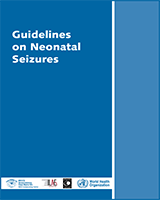All rights reserved. Publications of the World Health Organization are available on the WHO web site (www.who.int) or can be purchased from WHO Press, World Health Organization, 20 Avenue Appia, 1211 Geneva 27, Switzerland (tel.: +41 22 791 3264; fax: +41 22 791 4857; e-mail: tni.ohw@sredrokoob). Requests for permission to reproduce or translate WHO publications – whether for sale or for noncommercial distribution – should be addressed to WHO Press through the WHO web site (http://www.who.int/about/licensing/copyright_form/en/index.html).
NCBI Bookshelf. A service of the National Library of Medicine, National Institutes of Health.
Guidelines on Neonatal Seizures. Geneva: World Health Organization; 2011.
Neonatal seizures represent one of the most frequent neurological events in newborn infants, often reflecting a variety of different pre-, peri-, or postnatal disorders of the central nervous system (CNS). They are also a common manifestation of metabolic abnormality in newborn period and often represent the first sign of neurological dysfunction in neonates. They may be symptomatic or cryptogenic, herald subsequent epilepsy, can be associated with potential morbidity and mortality, and may be used as a factor in considering long-term prognosis. Despite the enormous clinical significance of these events, many aspects of their management are not well supported with evidence-based recommendations.
In particular, rather few studies address issues related to the use of antiepileptic drugs (AEDs), such as indications for acute therapy, selection of first-line and second-line agents, pharmacokinetics of commonly used AEDs, and duration of treatment after the seizures are controlled on AEDs for neonatal seizures (NS).
The Global Campaign Against Epilepsy, a World Health Organization (WHO) partnership with the International League Against Epilepsy (ILAE) and the International Bureau of Epilepsy (IBE), in collaboration with the Institute for Research on Mental Retardation and Brain Aging (IRCCS) named Associazione Oasi Maria SS., a WHO Collaborating Centre for Training and Research in Neuroscience (WHO/CC), initiated a project to develop evidence-based guidelines for the management of neonatal seizures. These guidelines are intended to be of use for neonatologists, paediatric neurologists, paediatricians, general practitioners, nurse practitioners, nurses and other health professionals who may be in contact with infants experiencing seizures within the first 28 days of life (age up to 44 weeks post-conception). The guidelines are framed so as to be applied by health care providers practicing in a wide range of health care facilities, from those with limited resources to tertiary care centres.
The Guideline Development Group identified 11 research questions to be of highest priority. Two of these questions were background questions on prevalence of neonatal seizures and predictors of prognosis of neonatal seizures. The remaining 9 questions focused on priority issues related to management of neonatal seizures. The Grading of Recommendations Assessment, Development, and Evaluation (GRADE) approach was used for grading the quality of evidence after adaptation to the relevant working area. The quality of the evidence for an outcome was graded as follows: high, moderate, low or very low. After grading the available studies for each outcome, recommendations were formulated on the basis of the summary and quality of evidence, balance between benefits and harms, values and preferences of policy makers, health care providers and parents, feasibility and resource use; in addition, costs were analyzed to see whether they could be qualitatively justifiable by the benefits. The recommendations were graded into two types: strong and weak. In some cases, the recommendations were context-specific which is indicated in the document as appropriate.
Table 1 lists the key recommendations of the guidelines:
TABLE 1
KEY RECOMMENDATIONS OF NEONATAL SEIZURES GUIDELINES.
- EXECUTIVE SUMMARY - Guidelines on Neonatal SeizuresEXECUTIVE SUMMARY - Guidelines on Neonatal Seizures
- Uncharacterized protein CELE_F53F10.2 [Caenorhabditis elegans]Uncharacterized protein CELE_F53F10.2 [Caenorhabditis elegans]gi|1831505595|ref|NP_001368678.1|Protein
- G_PROTEIN_RECEP_F1_2 domain-containing protein [Caenorhabditis elegans]G_PROTEIN_RECEP_F1_2 domain-containing protein [Caenorhabditis elegans]gi|17507157|ref|NP_492991.1|Protein
Your browsing activity is empty.
Activity recording is turned off.
See more...
